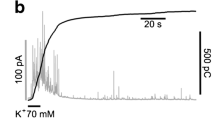Summary
In the intact, in vitro frog skin, isoproterenol (ISO) stimulates and amiloride-insensitive increase in short-circuit current (SCC) that can be localized to the exocrine glands and is associated with secretion of chloride. To determine which cells in the glands respond to stimulation we measured the intracellular electrolyte concentrations of the various cell types of the mucous and seromucous glands of the skin using freeze-dried cryosections and electron microprobe analysis. In the resting state, the various cell types of the glands have intracellular electrolyte concentrations similar to the epithelial cells of the skin. Exposure to amiloride (10−4 m) has little effect on the concentration of Na and Cl in the cells of the glands. The effect of isoproterenol has two distinct phases. Analysis of glands in tissues frozen at the peak of the SCC response (13 min after addition of isoproterenol) shows that the only significant change is an increase in Na and Ca in a group of cells at the ductal pole of the acini of both gland types. These are termed “gland” cells. The duct cells and cells that secrete macromolecules did not show any significant changes at this timepoint. In the gland cells, after a one-hour exposure to isoproterenol the Na concentration is at prestimulation levels while Cl drops. There is also a smaller drop in Cl in the duct and skin epithelial cells. Ouabain, which can completely block the isoproterenol SCC response, has little short-term effect on Na and Cl in the control gland but accentuates the gain of Na and drop in Cl in the isoproterenol-treated condition. Bumetanide and, to a lesser extent, furosemide, also blocks the isoproterenol SCC response and causes a further drop in Cl. The results provide indirect evidence that a major portion of the ionic component of the gland secretion is produced by a distinct group of cells separate from those producing the macromolecular component and that the mechanism of secretion involves a Na:Cl coupled transport system linked to the activity of the basolateral Na pump.
Similar content being viewed by others
References
Bauer, R., Rick, R. 1978. Computer analysis of X-ray spectra (EDS) from thin biological specimens.X-Ray Spectrom 7:63–69
Benson, B.J., Hadley, M.E. 1969. In vitro characterization of adrenergic receptors controlling skin gland secretion in two anurans;R. pipiens andXenopus laevis.Comp. Biochem. Physiol. 30:857–864
Candia, O.A., Schoen, H.F. 1978. Selective effects of bumetanide on chloride transport in bullfrog cornea.Am. J. Physiol. 234:F297-F301
Dockray, G.J., Hopkins, C.R. 1975. Caerulein secretion by dermal glands inXenopus laevis.J. Cell Biol. 64:724–733
Dörge, A., Rick, R., Gehring, K., Thurau, K. 1978. Preparation of freeze-dried cryosections for quantitative X-ray microanalysis of electrolytes in biological soft tissues.Pfluegers Arch. 373:85–97
Frizzell, R.A., Field, M., Schultz, S.G. 1979. Sodium-coupled chloride transport by epithelial tissues.Am. J. Physiol. 236:F1-F8
Furuta, Y., Hashimoto, K., Waslizaki, M. 1978. Beta adrenergic stimulation of exocrine secretion from the rat pancreas.Br. J. Pharmacol. 62:25–29
Hoffman, C.W., Dent, J.N. 1977. Effects of neurotransmitters upon the discharge of secretory product from the cutaneous glands of the red-spotted newt.J. Exp. Zool. 202:155–161
Jehl, B., Bauer, R., Dörge, A., Rick, R. 1981. The use of propane/isopentane mixtures for rapid freezing of biological specimens.J. Microsc. 123:307–309
Koefoed-Johnson, V., Ussing, H.H., Zerahn, K. 1952. The origin of the short-circuit current in the adrenaline stimulated frog skin.Acta Physiol. Scand. 27:38–48
Mills, J.W., Prum, B.E. 1984. Morphology of the exocrine glands of the frog skin.Am. J. Anat. 171:91–106
Neutra, M.R., Leblond, C.P. 1966. Synthesis of the carbohydrate of mucus in Golgi complex as shown by electron microscope radioautography of goblet cells injected with glucose-H3.J. Cell Biol. 72:23–30
Palfrey, H.C., Feit, P.W., Greengrad, P. 1980. cAMP-stimulated cation cotransport in avian erythrocytes: Inhibition by “loop” diuretics.Am. J. Physiol. 238:C139-C140
Rick, R., Dörge, A., Arnim, E. von, Thurau, K. 1978. Electron microprobe analysis of frog skin epithelium: Evidence for a syncytial sodium transport compartment.J. Membrane Biol. 39:313–331
Rick, R., Dörge, A., Thurau, K. 1981. Electron microprobe analysis of frog skin epithelium: Pathway of transepithelial Na transport.In: Ion Transport by Epithelia. Society of General Physiologists Series, S.G. Schultz, editor. Vol. 36, pp. 197–208. Raven Press, New York
Rick, R., Dörge, A., Thurau, K. 1982. Quantitative analysis of electrolytes in frozen dried sections.J. Microsc. 125:239–247
Sato, K. 1977. The physiology, pharmacology and biochemistry of the eccrine sweat gland.Rev. Physiol. Biochem. Pharmacol. 79:51–131
Silva, P.J., Stoff, S., Field, M., Fine, L., Forrest, J.N., Epstein, F. 1977. Mechanism of active chloride secretion by shark rectal gland: Role of Na−K-ATPase in chloride transport.Am. J. Physiol. 233:F298-F306
Skoglund, C.E., Sjöberg, E. 1977. In vivo studies of individual mucous glands in the frog.Acta. Physiol. Scand. 100:471–484
Skorofsky, S.R., Field, M., Fozzard, H.A. 1982. The cellular mechanism of active chloride secretion in vertebrate epithelia: Studies in intestine and trachea.Phil. Trans. R. Soc. London B 299:597–607
Spring, K.R., Ericson, A.-C. 1982. Epithelial cell volume modulation and regulation.J. Membrane Biol. 69:167–176
Thompson, I.G., Mills, J.W. 1981. Isoproterenol-induced current changes in glands of frog skin.Am. J. Physiol. 241:C250-C257
Thompson, I.G., Mills, J.W. 1983. Chloride transport in glands of frog skin.Am. J. Physiol. 244:221-C226
Watlington, C.O. 1968. Effect of catecholamines and adrenergic blockade on sodium transport of isolated frog skin.Am. J. Physiol. 214:1001–1007
Welsh, M.J. 1983. Intracellular chloride activities in canine tracheal epithelium: Direct evidence for sodium-coupled intracellular chloride accumulation in a chloride-secreting epithelium.J. Clin. Invest. 71:1392–1401
Welsh, M.J., Smith, P.J., Frizzell, R.A. 1983. Intracellular chloride activities in the isolated perfused shark rectal gland.Am. J. Physiol. 245:F640-F644
Young, J.A., Lennup, E.W. van 1978. The morphology of salivary glands. pp. 26–27. Academic Press, New York
Author information
Authors and Affiliations
Rights and permissions
About this article
Cite this article
Mills, J.W., Thurau, K., Doerge, A. et al. Electron microprobe analysis of intracellular electrolytes in resting and isoproterenol-stimulated exocrine glands of frog skin. J. Membrain Biol. 86, 211–220 (1985). https://doi.org/10.1007/BF01870600
Received:
Revised:
Issue Date:
DOI: https://doi.org/10.1007/BF01870600




